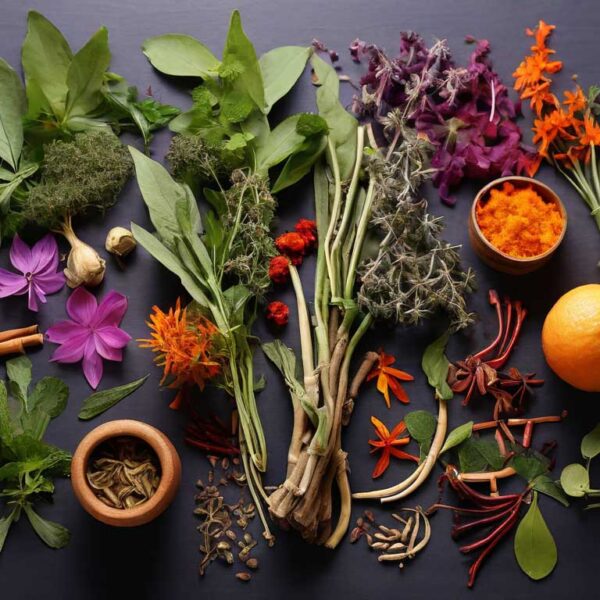
“Soothing Solutions: Ayurvedic Pain Relief 4 Herbal Remedies for Natural Pain Relief”
Hook Ayurvedic Pain Relief:
Discover the healing power of Ayurvedic herbs for alleviating aches and Ayurvedic Pain Relief naturally. Dive into the ancient wisdom of Ayurveda to find relief from discomfort and promote overall well-being.
Understanding Pain in Ayurveda:
In the holistic paradigm of Ayurveda, pain is not merely perceived as a physical sensation but rather as a manifestation of underlying imbalances within the body’s subtle energies, known as doshas. According to Ayurvedic philosophy, these doshas—Vata, Pitta, and Kapha—are fundamental principles governing various physiological and psychological functions. When these doshas are in a state of equilibrium, health and vitality prevail. However, imbalances in the doshas can lead to discomfort, pain, and a diminished sense of well-being.
Vata, representing the elements of air and ether, governs movement and communication within the body. When Vata is aggravated or imbalanced, it can manifest as pain characterized by qualities such as dryness, coldness, and instability. Common examples include joint pain, muscle stiffness, and nerve-related discomfort.
Pitta, associated with the fire and water elements, governs metabolism, digestion, and transformation. Pitta imbalance may lead to inflammatory conditions and intense, burning sensations. Pain related to Pitta imbalance often presents as inflammation, heat, and sensitivity, such as in cases of digestive issues, acidity, or skin irritations.
Kapha, representing earth and water elements, governs structure, stability, and lubrication. When Kapha is out of balance, it can result in heaviness, stagnation, and congestion, leading to dull, achy pain. Conditions such as swelling, edema, and respiratory congestion often correlate with Kapha imbalance.
Ayurvedic Pain Relief philosophy emphasizes the importance of addressing the root cause of pain to restore harmony and promote optimal health. Rather than merely masking symptoms, Ayurvedic approaches aim to identify and address the underlying imbalances contributing to pain. This holistic perspective recognizes that pain is often a multifaceted phenomenon influenced by physical, mental, emotional, and energetic factors.
Ayurvedic therapies for pain relief encompass a diverse range of modalities, including herbal remedies, dietary adjustments, lifestyle practices, and therapeutic treatments such as massage, yoga, and meditation. By restoring balance to the doshas, supporting the body’s natural healing mechanisms, and promoting holistic well-being, Ayurveda offers a comprehensive approach to addressing pain and fostering vitality at all levels of being.
The Role of Ayurvedic Herbs in Ayurvedic Pain Relief:
Ayurvedic herbs offer gentle yet effective solutions for managing various types of pain, including musculoskeletal pain, headaches, and menstrual cramps. These herbs possess anti-inflammatory, analgesic, and muscle-relaxing properties, helping to alleviate discomfort and support the body’s natural healing processes.
DIY Ayurvedic Pain Relief Recipes for Natural Pain Relief:
- Turmeric Golden Milk:
- Ingredients:
- 1 cup of milk (dairy or plant-based)
- 1 teaspoon of turmeric powder
- 1/2 teaspoon of ginger powder
- 1/4 teaspoon of cinnamon powder
- 1 teaspoon of honey (optional)
- Instructions:
- Heat the milk in a saucepan over medium heat.
- Add turmeric, ginger, and cinnamon powder.
- Stir well and simmer for 5 minutes.
- Sweeten with honey if desired and enjoy as a soothing drink to relieve inflammation and pain.
- Ingredients:
- Ginger Compress:
- Ingredients:
- 2 tablespoons of grated fresh ginger
- 2 cups of hot water
- Clean cloth or towel
- Instructions:
- Steep grated ginger in hot water for 10 minutes.
- Soak the cloth or towel in the ginger-infused water.
- Wring out excess liquid and apply the warm compress to the affected area for 10-15 minutes.
- Repeat as needed to reduce pain and inflammation.
- Ingredients:
- Clove Oil Massage:
- Ingredients:
- 2-3 drops of clove essential oil
- 1 tablespoon of carrier oil (such as coconut or sesame oil)
- Instructions:
- Mix clove essential oil with a carrier oil in a small bowl.
- Gently massage the oil onto the affected area using circular motions.
- Continue massaging for 5-10 minutes to relieve muscle tension and pain.
- Ingredients:
- Peppermint Headache Balm:
- Ingredients:
- 2 tablespoons of coconut oil
- 5-7 drops of peppermint essential oil
- Instructions:
- Mix coconut oil with peppermint essential oil in a small container.
- Apply the balm to the temples and forehead, avoiding the eyes.
- Massage gently to relieve tension and soothe headaches.
- Ingredients:
Benefits of Ayurvedic Herbal Remedies for Natural Pain Relief: Ayurvedic Pain Relief herbal remedies offer numerous benefits for managing pain naturally, including:
Ayurvedic Pain Relief herbal remedies stand as nature’s balm, offering a plethora of benefits for managing pain naturally and restoring harmony to the body, mind, and spirit. Rooted in ancient wisdom and backed by modern science, these remedies provide holistic relief from discomfort, promoting overall well-being and vitality.
One of the primary benefits of Ayurvedic Pain Relief herbal remedies for natural pain relief is their ability to reduce inflammation and swelling. Herbs such as Turmeric, Ginger, and Boswellia possess potent anti-inflammatory properties that help mitigate the inflammatory response, easing pain and discomfort associated with conditions such as arthritis, tendonitis, and inflammatory bowel diseases.
Moreover, Ayurvedic Pain Relief herbal remedies offer effective relief from musculoskeletal pain and stiffness. Herbs like Ashwagandha, Guggul, and Shallaki have analgesic and muscle-relaxant properties that alleviate muscle tension, stiffness, and discomfort, promoting flexibility, and mobility. These herbs support the body’s natural healing processes, allowing individuals to move with greater ease and comfort.
Furthermore, Ayurvedic herbal remedies provide relief from headaches, migraines, and menstrual cramps, offering a natural alternative to conventional pain medications. Herbs such as Feverfew, Peppermint, and Cramp Bark help soothe headaches, reduce migraine frequency and intensity, and alleviate menstrual cramps and discomfort. By addressing the underlying imbalances contributing to pain, these remedies offer lasting relief and support menstrual health and well-being.
In addition, Ayurvedic Pain Relief herbal remedies contribute to improved circulation and mobility, enhancing overall health and vitality. Herbs like Guggul, Garlic, and Hawthorn promote cardiovascular health, improve blood flow, and reduce the risk of circulation-related pain and discomfort. By supporting circulation and oxygenation of tissues, these herbs aid in the repair and regeneration of damaged tissues, promoting faster recovery and enhanced mobility.
Moreover, Ayurvedic Pain Relief herbal remedies provide support for overall well-being and vitality, addressing pain at its root cause and fostering holistic health. By restoring balance to the doshas, supporting the body’s natural healing mechanisms, and promoting relaxation and rejuvenation, these remedies empower individuals to experience greater vitality, resilience, and quality of life.
In conclusion, Ayurvedic Pain Relief herbal remedies offer comprehensive relief from pain and discomfort, addressing the root cause of pain and promoting holistic well-being. By reducing inflammation and swelling, alleviating musculoskeletal pain and stiffness, relieving headaches, migraines, and menstrual cramps, improving circulation and mobility, and supporting overall health and vitality, these remedies provide a natural and effective solution for managing pain and fostering vitality at all levels of being.
Incorporating Ayurvedic Lifestyle Practices:
In Ayurveda, lifestyle practices are integral components of holistic healing, working synergistically with herbal remedies to promote natural pain relief and overall well-being. By incorporating Ayurvedic lifestyle practices into daily routines, individuals can enhance the effectiveness of herbal remedies, reduce pain and discomfort, and cultivate a state of balance and vitality.
Practicing gentle yoga and stretching exercises is a cornerstone of Ayurvedic pain management. Yoga postures, such as gentle stretches, twists, and restorative poses, help improve flexibility, release muscle tension, and promote circulation, alleviating stiffness and discomfort in the body. Incorporating regular yoga practice into daily routines supports joint health, enhances mobility, and fosters a sense of relaxation and well-being.
In addition to yoga, Ayurvedic Pain Relief recommends stress-relief techniques such as meditation and deep breathing to complement natural pain relief. Meditation practices, such as mindfulness meditation and body scan meditation, help calm the mind, reduce stress, and enhance awareness of bodily sensations, reducing the perception of pain. Deep breathing exercises, such as diaphragmatic breathing and alternate nostril breathing, promote relaxation, activate the body’s relaxation response, and ease discomfort associated with pain.
Maintaining a balanced diet is essential for supporting natural pain relief and overall health. Ayurvedic Pain Relief emphasizes consuming a diet rich in anti-inflammatory foods such as fruits, vegetables, whole grains, and healthy fats, while minimizing processed foods, refined sugars, and inflammatory ingredients. Incorporating herbs and spices such as turmeric, ginger, and garlic into meals provides additional anti-inflammatory benefits, reducing pain and inflammation in the body.
Furthermore, prioritizing adequate rest and sleep is crucial for supporting the body’s natural healing processes and rejuvenating tired muscles. Ayurveda recommends establishing a regular sleep routine, ensuring a comfortable sleep environment, and practicing relaxation techniques before bedtime to promote restful sleep. Quality sleep allows the body to repair and regenerate tissues, reduce inflammation, and alleviate pain, contributing to overall well-being and vitality.
By integrating these Ayurvedic lifestyle practices into daily routines, individuals can enhance the effectiveness of herbal remedies for natural pain relief, reduce pain and discomfort, and cultivate a state of balance, vitality, and well-being. Together, these holistic approaches empower individuals to manage pain naturally, support overall health, and thrive in mind, body, and spirit.
Food For Thought:
Experience the transformative power of Ayurvedic Pain Relief herbal remedies for natural pain relief. By incorporating these DIY recipes and lifestyle practices into your routine, you can find relief from discomfort and promote overall well-being, naturally and holistically.



